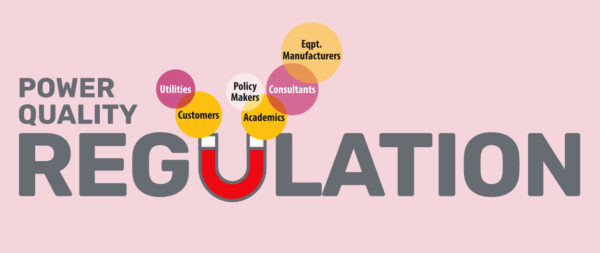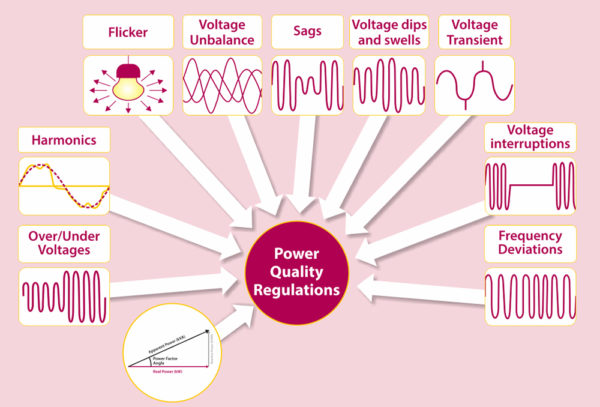Published On: Mar 10, 2019
|
While India’s power sector has made several strides in the last few years, there are several critical gaps such as Power Quality that are yet to be addressed. Incidentally, April and May is also a season laden by spurt in energy demand and stressed power generation, a testing time in general for the mettle of India’s electrical sector. The parliamentary elections are around the corner and for the first time, electricity is being stated as an achievement not an issue that has remained to be resolved. Overall, it’s an opportune time to take stock of the primary growth engine for the Indian economy – the power sector – and assess the state of future of power quality! |
INTRODUCTION
The power sector in India is abuzz with several milestone achievements..
- 1 Lakh MW generation capacity added. (2,43,029 MW in March 2014 to 3,44,002 MW in March 2018)
- India emerges as net exporter of electricity. 7203 MU supplied to Nepal, Bangladesh and Myanmar in FY 2017-18.
- Energy deficit reduced from 4.2 per cent (in FY 2013-14) to 0.7 per cent (in FY 2017-18)
- Expansion of transmission grid by 1 lakh ckm
- 100% of Villages are now electrified
- India’s rank improved to 29 in 2018 from 111 in 2014 on World Bank’s Ease of Getting Electricity Ranking
- Launched for universal electrification
- Roadmap for 24*7 power supply prepared. States ready to ensure 24*7 Power for All from 1st April, 2019
- 107 crore LED bulbs distributed
The number of schemes and initiatives for the power sector has also been one of the highest in recent times. The key initiatives launched by Power Ministry and other related bodies include:
- SAUBHAGYA for household electrification
- Vidyut Pravah for Power Exchange
- UJALA to bring affordable LED`S for All
- UrjaMitra to monitor power availability
- MERIT–showing marginal variable cost and source wise purchase of electricity
- UDAY monitors DISCOMs on the basis of 26 major performance parameters
- URJA (Urban Jyoti Abhiyaan) to capture Consumer parameters under IPDS.
- TARANG is Transmission App for real time monitoring & Growth
- DEEP is a common national e-bidding platform for power procurement
- Ash Track- linking fly ash users and power plants for better ash utilization
While the absence of Power Quality is evident, on the whole, with all the efforts and success mentioned above, it appears that India is about to put behind the challenge of ‘availability’ of power. Is it then time to shift the discourse and discussion to the next set of challenges?
And the prominent among all is the problem of Quality of power that’s being made available. The data above shows that there is very little that’s being done presently to improve the Power Quality.
There are many questions to be answered…what is the length, breadth and depth of the problem of Quality Power? Is it comparable in magnitude to the ‘availability’ problem? How long will it take us to solve? Are we ready to solve it? But before that, it’s interesting to see how it has always been there and at times challenging the availability of power as well.
BEYOND AVAILABILITY – IS INDIA READY TO THINK ‘POWER QUALITY’?
Understanding the changing role of electricity for consumers
The role of electricity is changing. For instance, take the case of consumer in the city. With extensive applications of power electronic equipment, other needs of Heating, Lighting, Communication, Entertainment etc; which are dependent on reliable power, have become a part and parcel of the consumers’ daily lives. In fact, the use of some of this equipment has become imperative rather than option. Take the case of a person losing all her/his contacts, communication and even memorable photographs due to crash of computer hard disk impacted by poor power quality; it means a lifetime memory erased forever that cannot even be valued.
As a common man, ‘Power Quality’ would generally mean supply without interruptions and at an affordable rate per unit. However, PQ actually refers to the extent to which the power received at our homes is free of disturbances which would otherwise cause equipment to malfunction or fail.
The common perception of masses is that PQ is the power distribution utility’s responsibility and all issues/interruptions are because of their network infrastructure and services. It is being understood that as an end-user neither we have any control over it nor are we responsible for it. While there are certain external factors such as lightning, rain, winds, etc. that cause PQ problems, it will be hard to imagine that many of the PQ issues are due to what happens inside customer’s premises.
About 70-80% of power quality problems are caused inside a premise, due to equipment/appliance with low immunity or inadequate building wiring or incorrect grounding and also including large loads sharing the same circuits. These problems can be compounded by more frequent starting, running and stopping of electronic appliances and critical systems.
If a building is more than 15 years old, it probably wasn’t designed to meet the demands of today’s consumer devices and appliances.
Impact of PQ in industrial set-ups
For the industrial or commercial consumers, impact of poor PQ comes in more complex forms. With the increasing use of sensitive electronic equipment and addition of non-linear loads including renewable energy grids, PQ is a concern for industrial customers. Whether its voltage dips, spikes, harmonics or interruptions that last for only for a few milliseconds, the PQ issues can damage equipment, create nuisance disruptions in day-to-day operations and in worst cases pose a severe risk to safety and reliability of power systems as a whole.
In addition to the indirect costs, industrial customers are penalised directly by the Utility companies for not maintaining their PF. In worst cases, the penalties have been in excess of 10% of the total energy bills.
Availability is taken for granted, but quality is still NOT the concern
So, on one hand we have the Indian consumers who now expect electricity to be a product where availability is taken for granted and quality is the focus. For the industrial and commercial customers, PQ is vital to defining the competitive capability of their infrastructure at every level – may it be modern industry 4.0 production facility or a sim operated IoT based pump working in a remotely located village.
But in spite of its severe consequences the awareness about PQ is low. The perception that availability, and not the quality, is a real win, still remains dominant among both the consumers and planners/policy makers. The issue of Power Quality is still a long way from taking the centre stage.
PQ GAPS IN INDIA – CAN REGULATIONS SHOW THE WAY?
In India, we have unknowingly accepted poor PQ as a norm and worked around the solutions. For instance, the fact that the Indian UPS market is almost equal to the Chinese market size in spite of demand in India being 1/3rd as compared to that in China. Imagine the inefficiencies we are adding in our system due to unreliable power. That also brings me to an important question concerning the ‘quality’ of power, the what kind of power quality are we seeking?
Because you have customers who are just fine installing one equipment after the other to reduce the risk from poor PQ. You also have consumers who have learnt to live with the circumstances of poor PQ, as a standard operating risk in the business.
Also, PQ is also perceived differently at different levels. For example, 1 min interruption in a city such as Mumbai may be too bad but at a rural village level even 1 hr of interruption may be considered to be normal.
In such a precarious situation, who owns the responsibility towards PQ – do the consumers pay for their protection against risks? Or the aim should be to permanently eliminate the risks, uncertainties and free the consumers from additional costs of poor PQ? The Utilities, another key stakeholder in improving PQ do not seem to have clear answers at the moment. That’s the key gap in addressing the PQ challenges before India.
Can regulations show the way?
And it’s here that a strong case for regulations to show the way comes in to the picture. Any Quality aspiration must be backed up by strong standard and supported by equally robust regulation. More importantly, the efforts to improve standard and enforce the regulation too for PQ have to be at all the levels, from the Utility, Feeder to the end consumers.
a study of Power Quality Regulation in India and Abroad authored by Dr. G. Bhuvaneswari and Prof. Bhim Singh Department of Electrical Engineering IIT Delhi, INDIA – published by APQI in 2011 observed that in India, the power quality standards are yet to be evolved although there are general guide lines regarding supply code and standards of performance.
In India, we are racing against time to establish high level of PQ standards in a short time. As Power Systems in India face introduction of an unprecedented number of sensitive equipment, non-linear loads, renewable energy integration and a numerous other factors hampering the Power Quality, pulling off the feat to achieve high PQ is a stretch target for everyone involved.
Average cost escalation due to power interruptions is estimated to be INR 2.65 Lakh Cr. per year
In the recent past, the industrial sector in India has been witnessing weekly interruptions ranging from less than one hour to more than 40 hours. Assuming an average interruption of say 30 minutes per week to the Industrial load (connected load is approx. 170 GW) in India, the average cost escalation accounts to be around INR 2.65 Lakh Cr. per year (assuming a very conservative cost escalation of INR 10 per minute per kW of connected industrial load). Hence, it is required in India, that a nation-wide survey is conducted to evaluate the various economic impacts of Poor Power Quality & bring awareness about the same.
PQ REGULATIONS IN INDIA – THE FIRST FEW STEPS
India has also taken a big step in framing the regulations for improving PQ. The recent report on ‘’PQ for Electricity Consumers in India released in 2018’’ and prepared by the sub-committee of Forum of Regulators, directs to include the power factor, frequency, reliability of supply and voltage regulations as Power Quality parameters.
The key PQ parameters as identified by the Forum of Regulators to be monitored for compliance include
- Frequency deviations
- Harmonics
- Voltage variations and Flicker
- Voltage unbalance
- Voltage dips and swells
- Voltage Transient
- Supply voltage interruptions
- Power Factor
|
You will notice that it is first major attempt to go beyond just the PF and look at a broader range of parameters that justify the true expanse of PQ. Until recently, there was no comprehensive national Power Quality Standard issued by Bureau of Indian Standards. Good news is that just last year BIS published its first national maiden standard IS 17036 on Voltage Quality in public distribution systems and it is just a beginning. But even with this, the PQ regulation in India can be said to address only the tip of the iceberg. The Powegrid’s Swachh Power report estimates the total investment required in initial phase for Power Quality improvement for the industrial, domestic and commercial loads to be about Rs. 24,840 Cr. This considers both installation of Power Conditioning devices and PQ monitoring devices at the LT level. |
But the Utilities also face the inevitable – lack of finances added with inability of their engineers and technicians, who lack the skills and experience to solve these problems. The dominant rhetoric so far has always been “when there is no availability what is the point of worrying about reliability”. The government-controlled utilities are in many ways detached from the situation with regard to PQ issues.
CONCLUSION
While India has crossed several key milestones in its rapid march towards ensuring affordable electrical power to every ‘willing’ consumer, it’s still a long way from claiming a victory. Especially, when benchmarked globally, India is still lagging behind by a generation or two when it comes to ensuring better quality of power and as a resultant – a whole new quality of life for consumers.
Given the lower awareness levels, lack of consensus among stakeholders and the hangover of an ‘availability’ focussed narrative, regulations seem to be a key and pivotal force to achieve better Power Quality.
REFERENCES
- Power Sector Achievement in India – DIPP Report – http://www.makeinindia.com/article/-/v/power-sector-achievement-report
- Achievements of Power Ministry during last 4 years – http://pib.nic.in/newsite/PrintRelease.aspx?relid=179769









